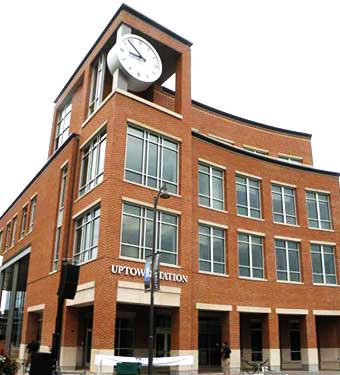Renovated train stations have the potential to spark greater economic development in the heart of their communities.
Investing in a station can be an investment in the future of your community. A renovated train station can inspire real estate growth, dining and entertainment development, tourism and local economic spending. Station improvements offer a return on investment for years to come. As alternative modes of transportation emerged over the years, some stations have been neglected. Fortunately, many communities actively exploring station redevelopment as a means to stimulate economic growth and revitalization are seeing success in ways they never imagined.
Across the country, Amtrak has witnessed towns and cities such as Hattiesburg, Miss. and Normal, Ill. invest in stations to yield sizable economic benefits including:
- Multi-million dollar private developments in surrounding areas to include housing and retail
- Restored parks and civic and private buildings
- Investments in art centers hosting world class performances
- Housing improvements including increases to home values
- Tourism growth
Normal, IL: Building a Local Landmark
Normal’s Uptown Station opened in June 2012 to anchor the redevelopment of the traditional commercial district—rebranded “Uptown Normal”—east of Illinois State University. Eleven years in the making from initial concept to completion, the new 68,000 square foot transportation center brings together the services of Amtrak trains, intercity and Bloomington-Normal Public Transit system buses, airport shuttles, taxis and bicycles.
opened in June 2012 to anchor the redevelopment of the traditional commercial district—rebranded “Uptown Normal”—east of Illinois State University. Eleven years in the making from initial concept to completion, the new 68,000 square foot transportation center brings together the services of Amtrak trains, intercity and Bloomington-Normal Public Transit system buses, airport shuttles, taxis and bicycles.
Constructed of classic red brick, the building features a prominent corner clock tower that has become a neighborhood landmark. The complex contains retail and municipal office space, including City Council Chambers, a community room for use by local organizations, and a 380-car parking garage. It also incorporates numerous sustainable features such as a green roof that is partially planted in vegetation to absorb rainwater and cool the building.
The prospects of high-speed links as well as renewed utilities, roadways and streetscaping in the Uptown area, have attracted development that is transforming the blocks adjacent to the transportation center.
The $45.6 million project was funded through a variety of sources including a $22 million Transportation Investments Generating Economic Recovery (TIGER) grant; $10.5 million in grants from the FTA’s Bus and Bus Facilities program; $13.2 million from the Illinois Department of Commerce and Economic Opportunity and bonds issued by the town.
The prospects of high-speed links to Chicago and St. Louis, as well as renewed utilities, roadways and streetscaping in the Uptown area, have attracted development that is transforming the blocks adjacent to the transportation center. The redevelopment plan includes the rehabilitation of existing structures and the erection of new buildings to create a mixed-use neighborhood that fosters activity throughout the day and evening. To further redevelopment, the city also backed the creation of the Children’s Discovery Museum and a large tree-lined traffic roundabout that doubles as an attractive public space.
One new tenant credits Uptown Station as a prime factor in its decision to build in the neighborhood. In a letter of support for the city’s TIGER application, the general manager of the Bloomington-Normal Marriott Hotel and Conference Center wrote: “In selecting a site for our new [$72 million] hotel and convention center we were attracted to Uptown Normal in large part due to the planned transportation hub…[which will] undoubtedly help the Marriott attract business to the region and will serve as an economic engine for the foreseeable future.”


 Amtrak established the Great American Stations Project in 2006 to educate communities on the benefits of redeveloping train stations, offer tools to community leaders to preserve their stations, and provide the appropriate Amtrak resources.
Amtrak established the Great American Stations Project in 2006 to educate communities on the benefits of redeveloping train stations, offer tools to community leaders to preserve their stations, and provide the appropriate Amtrak resources. Amtrak is seizing a once-in-a-lifetime opportunity to transform rail and Retrain Travel. By modernizing, enhancing and expanding trains, stations and infrastructure, Amtrak is meeting the rising demand for train travel. Amtrak offers unforgettable experiences to more than 500 destinations across 46 states and parts of Canada. Learn more at
Amtrak is seizing a once-in-a-lifetime opportunity to transform rail and Retrain Travel. By modernizing, enhancing and expanding trains, stations and infrastructure, Amtrak is meeting the rising demand for train travel. Amtrak offers unforgettable experiences to more than 500 destinations across 46 states and parts of Canada. Learn more at